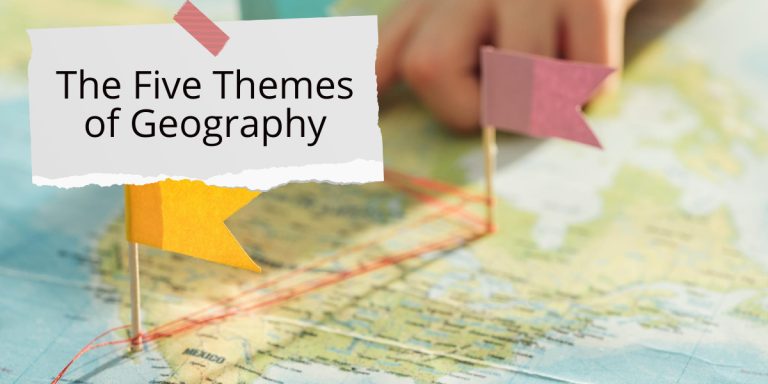The Five Themes of Geography: A Comprehensive Exploration
Geography is a multifaceted discipline that encompasses the study of the Earth’s surface and the relationships between people and their environments. To facilitate understanding and analysis, geographers have identified five themes that serve as a framework for organizing geographic information and concepts. These themes provide a structured approach to exploring the complexities of our world, guiding us in understanding the interactions between human societies and the natural environment.
1. Location: The Anchor of Geography
Location serves as the cornerstone upon which geographical analysis is built. It paints the coordinates of our world, providing the coordinates that anchor every place on Earth. There are two fundamental aspects to location: absolute and relative. While absolute location pinpoints a place’s precise coordinates on the Earth’s surface—expressed in latitude and longitude, relative location defines a place in relation to its surrounding landmarks or geographic features.
Real-World Example:
Consider the bustling metropolis of New York City. Its absolute location, approximately 40.7128° N, 74.0060° W, places it precisely on the map. However, its relative location, nestled along the eastern seaboard of the United States, positions it as a gateway to international trade and a cultural hub of the nation.
2. Place
“Place” is not just a set of geographical coordinates, but it includes all the unique aspects that make a location special. These aspects include both physical attributes, such as landforms, climate, and vegetation, and human characteristics, such as culture, language, and architecture, that give a place its identity. Every place has been shaped by its past through the interaction of natural forces and human endeavors, leaving an indelible imprint that defines its character..
Real-World Example:
Let’s journey to the Galápagos Islands, an archipelago renowned for its extraordinary biodiversity and ecological significance. Beyond its volcanic landscapes and pristine shores, the islands harbor a unique tapestry of life, including species found nowhere else on Earth. Moreover, its isolation has nurtured a distinct human culture—a harmonious coexistence between inhabitants and their natural surroundings, exemplifying the profound connection between people and place.
3. Human-Environment Interaction: Balancing Act of Survival
Human-environment interaction lies at the heart of geography, spotlighting the intricate interaction between human societies and the natural world. It scrutinizes the impact of human activities on the environment and the reciprocal influence of the environment on human societies. From agricultural practices and urbanization to resource exploitation and pollution, human actions reverberate across the Earth’s ecosystems, shaping landscapes and livelihoods alike.
Real-World Example:
The Amazon Rainforest serves as a crucial symbol of the delicate balance between humans and their environment. Its Rain forest supports a diverse array of life. However, human activities, such as deforestation for agriculture and illegal logging, pose significant threats to its ecological integrity. The interconnected relationships among indigenous communities, biodiversity, and global climate patterns highlight the intricate dynamics of human-environment interactions.
4. Movement: Bridging Boundaries, Defying Distance
The movement of people, goods, ideas, and information across the Earth’s surface shows how interconnected our world is. This includes various forms of mobility such as migration, trade, communication, and transportation networks that go beyond geographical barriers. It is crucial to understand the patterns of movement to understand globalization, cultural diffusion, and the spatial dynamics of human societies.
Real-World Example:
Cast your gaze back to the ancient Silk Road—a network of trade routes that traversed the vast expanse of Eurasia, connecting civilizations and catalyzing cultural exchange. Along these ancient thoroughfares, merchants traded silk, spices, and precious commodities, forging pathways of prosperity and cultural diffusion that endure to this day. The Silk Road epitomizes the transformative power of movement, transcending borders and reshaping the contours of human civilization.
5. Region: Forging Bonds Amidst Diversity
Geographers use regions as a way to understand patterns and group territories based on shared characteristics. These characteristics can be physical, cultural, economic, or political and can provide insights into how our world is spatially organized. Regions offer a rich diversity of landscapes, cultures, and socio-economic dynamics, which help us better understand the complexities of human geography.
Real-World Example:
Enter the European Union (EU), a beacon of regional integration and cooperation on the global stage. Spanning across diverse landscapes and cultures, the EU transcends national borders, fostering economic unity, political cohesion, and cultural exchange among its member states. The EU exemplifies the transformative potential of regional collaboration, transcending historical divisions and forging a common destiny amidst the tapestry of Europe’s diverse landscapes.
Conclusion: Five Themes of Geography
In essence, the five themes of geography serve as a compass, guiding us through the labyrinth of our world’s geography. From the foundational pillars of location and place to the dynamic interplay of human-environment interaction, movement, and region, these themes offer a roadmap for understanding the intricacies of our planet. By unraveling the tapestry of geography, we gain profound insights into the interconnectedness of humanity and the world we inhabit. As we navigate the ever-evolving landscapes of our planet, let us heed the wisdom embedded within these themes, for they are the keys that unlock the mysteries of our world.

